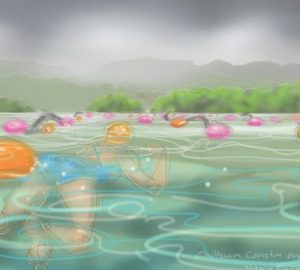
My first sports injury
Problem: I have my first serious sports injury. A combination of bad posture, cold weather and overuse has led to back and neck spasms. Everything hurts!
Exacerbating issue: It’s Christmas.
Details:
- No one who can help (physiotherapists, doctors, massage therapists, etc.) is working.
- I can’t sulk quietly in my room because there are numerous family functions to attend.
- Since it’s Christmas, I’m expected to be cheerier than usual at said functions.
- Failing to be cheery upsets my family, which upsets me further.
Apparently I don’t handle injury well. I have a classic Type A personality. According to Wikipedia, Type A people are ambitious, rigidly organised, impatient, proactive and take on more than they can handle. Me to a tee.
That’s why I am an athlete – exercising releases endorphins (natural uppers) to deal with the stress of being Type A, and training allows me constant control over something in my life, thus satisfying my Type A cravings. Without exercise I’m lost.
Not knowing what else to do, I grabbed my phone. Can’t the internet fix everything these days?
Apparently not. Google can’t diagnose injury. So instead I addressed my immediate problem – crying. Why was pain and unhappiness forcing water from my eyes?
There’s actually a good reason. Humans have two types of tears – crying, which is emotional shedding of tears, and lacrimation, which releases non-emotional tears (used to lubricate your eyes in cold or wind, or stop irritants – like onion dust – from reaching your eye). Given that there were no onions in the bathroom, I researched crying.
I learnt that tears come from the lacrimal gland, located near your nose. Strong emotions cause the gland to secrete a tear. You then spontaneously blink, which allows tears to be reabsorbed into the lacrimal punctum. The punctum drains into your nose (which is why your nose runs when you cry). If the volume of water is too large to be reabsorbed, the tears overflow and run down your face. This is embarrassing but there’s a good reason for it.
Humans are a social species where crying is a signal to other members of the tribe. It shows that the crier is distressed and in need of comfort. Crying also portrays vulnerability. This helps in confrontations – the attacker feels sorry for the crier, which makes the aggressor more lenient (this is why children cry when their parents are mad at them).
Physically crying improves your mood. Emotional tears contain leucine enkephalin, a natural painkiller and mood elevator. Crying also triggers the ‘fight or flight’ response in your body, which increases heartrate and sweating. This provides energy to deal with the immediate problem (and is the reason we feel tired after a long cry).
Does knowing this make me feel better? Actually, yes.
The leucine enkephalin seems to be working and my sister arrived to comfort me. Now I need to use my ‘fight or flight’ energy to get off the bathroom floor. It’s time to buck up and get to the physio.








